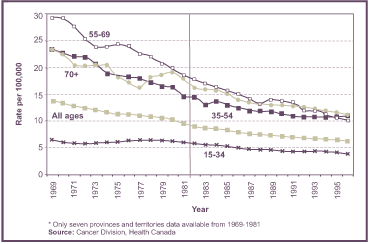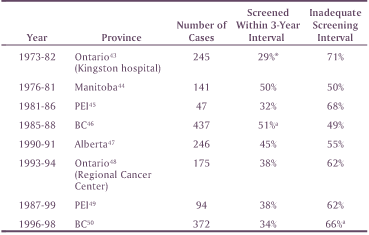ARCHIVED - Cervical Cancer Screening in Canada: 1998 Surveillance Report
5. Special Topic: Examination of Invasive Cervical Cancer
5.1 Morphology of Invasive Cervical Cancer
In Canada, squamous cell carcinomas account for about 70% of all types of cervical cancer, and adenocarcinomas and adenosquamous carcinomas for about 25%Footnote 1. These percentages are somewhat higher than the international averages of 75% and 10%-15% respectively. As has been reported in many countriesFootnote 27, there has been a steady decline over the last 30 years in the incidence of squamous cell carcinoma among all ages (Figure 7). By contrast, the incidence of adenocarcinoma has shown a steady increase in rates over the last two decades, especially among younger women (Figure 8)Footnote 37 Footnote 38. The Pap test has been shown to be less effective in detecting cervical adenocarcinoma than it is in detecting cervical squamous carcinomaFootnote 38-40 because adenocarcinomas arise further in the endocervical canal. Cervical brushes when used in combination with a spatula with an extended tip are now known to be more efficient than spatulas alone in collecting the endocervical cellsFootnote 41.
Figure 7: Age-standardized Incidence Rates by Age for Cervical Squamous Cell Carcinomas, Canada, 1969-96* (3-year moving average)

Figure 8: Age-standardized Incidence Rates by Age for Cervical Adenocarcinomas, Canada, 1969-96* (3-year moving average)

5.2 Screening History
Invasive cervical cancer can be prevented by regular screening. However, not all women are screened regularly, and even if they were it is not likely that cervical cancer would be completely eliminated. Particularly among young women, individuals infected with new oncogenic HPV types may, for some reason, be unduly susceptible and show rapid progression of abnormalities and subsequent disease. Such lesions develop too quickly to be detected by screening and this type of unfavourable natural history, though rare, may explain some of the deaths in women who had negative screens in the previous 3 yearsFootnote 42. Some Canadian studies have examined the influence of prior screening in patients who have developed invasive cervical cancer (Table 6). Regular screening was defined as laboratory evidence of a Pap test in the province during the 3 years before the histologic diagnosis, excluding tests within 6 months before the diagnosis. Unfortunately, as shown in Table 6, about 40% of cervical cancer cases in these studies were found in women who had been screened within the previous 3 years. Some of these cases were lost to appropriate management after screening revealed an abnormality. Elimination of these cases will require organized screening programs that include "fail-safe" mechanisms to encourage follow-up of abnormal screening results. Other women had a recent negative cytology report for either sampling or laboratory reasons. Possible causes include diagnosis of adenocarcinoma, difficulty detecting small numbers of abnormal cells, or inadequate sampling of the cervical cells.
Table 6: Review of Screening History for Canadian Women with Invasive Cervical Cancer

Table 6 also demonstrates that most Canadian women who develop cervical cancer (about 60%) had an inadequate screening interval. These included women with no laboratory evidence of a Pap test during the 3 years before the histologic diagnosis; in some cases there was no evidence of any Pap test. Elimination of these cases will require organized screening programs that actively recruit inadequately screened women. The major risk factor for development of cervical cancer is a lack of screening every 3 years.